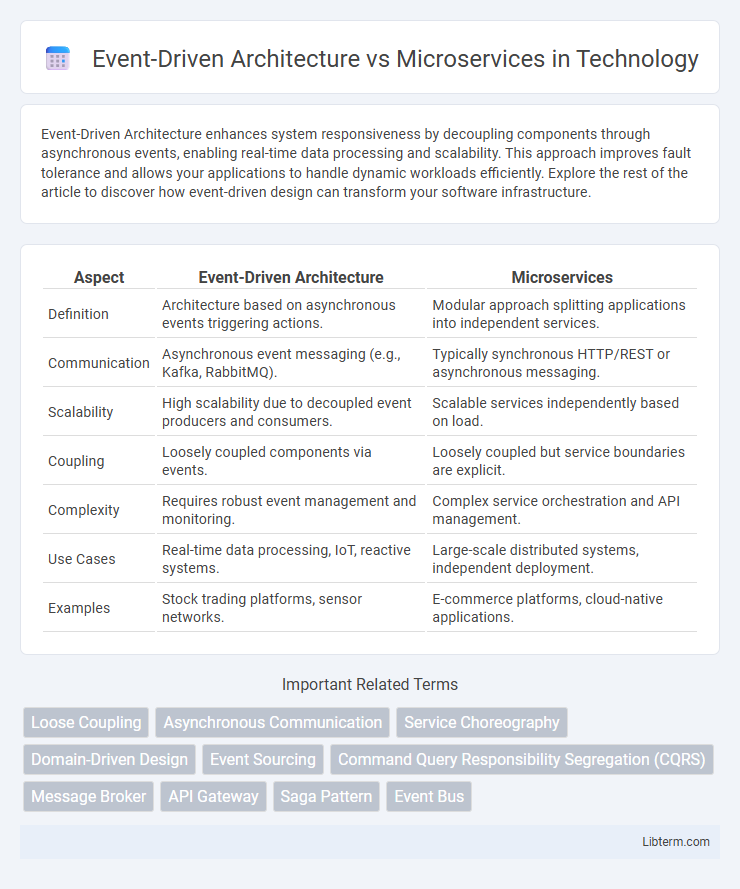Event-Driven Architecture enhances system responsiveness by decoupling components through asynchronous events, enabling real-time data processing and scalability. This approach improves fault tolerance and allows your applications to handle dynamic workloads efficiently. Explore the rest of the article to discover how event-driven design can transform your software infrastructure.
Table of Comparison
| Aspect | Event-Driven Architecture | Microservices |
|---|---|---|
| Definition | Architecture based on asynchronous events triggering actions. | Modular approach splitting applications into independent services. |
| Communication | Asynchronous event messaging (e.g., Kafka, RabbitMQ). | Typically synchronous HTTP/REST or asynchronous messaging. |
| Scalability | High scalability due to decoupled event producers and consumers. | Scalable services independently based on load. |
| Coupling | Loosely coupled components via events. | Loosely coupled but service boundaries are explicit. |
| Complexity | Requires robust event management and monitoring. | Complex service orchestration and API management. |
| Use Cases | Real-time data processing, IoT, reactive systems. | Large-scale distributed systems, independent deployment. |
| Examples | Stock trading platforms, sensor networks. | E-commerce platforms, cloud-native applications. |
Introduction to Event-Driven Architecture and Microservices
Event-driven architecture (EDA) emphasizes decoupled components that communicate through asynchronous events, enabling real-time data processing and scalability. Microservices architecture structures applications as a collection of independently deployable services, each responsible for specific business capabilities, promoting modularity and agility. Both paradigms enhance system flexibility and fault tolerance but differ in communication patterns and service granularity.
Core Principles of Event-Driven Architecture
Event-Driven Architecture (EDA) centers on the production, detection, and reaction to events, enabling real-time communication and decoupling of services. Core principles include event producers generating immutable events, event channels facilitating asynchronous message transmission, and event consumers reacting to these events to trigger business logic. This architecture enhances scalability, fault tolerance, and flexibility compared to traditional Microservices by promoting loose coupling and eventual consistency across distributed systems.
Key Concepts of Microservices Architecture
Microservices architecture is characterized by developing applications as a collection of small, independent services that communicate through lightweight protocols, typically HTTP or messaging queues. Each microservice is designed around specific business capabilities, ensuring modularity, scalability, and ease of deployment. Key concepts include decentralized data management, bounded contexts derived from domain-driven design, continuous delivery, and fault isolation, which collectively enhance system resilience and agility compared to monolithic or purely event-driven structures.
Comparison: Data Flow in Event-Driven vs Microservices
Event-Driven Architecture enables asynchronous data flow through events, allowing services to react to state changes without direct calls, which enhances scalability and decoupling. In contrast, Microservices often rely on synchronous communication via APIs, resulting in more direct but tightly coupled data exchange. Event-driven models promote eventual consistency, while microservices typically emphasize immediate consistency through request-response patterns.
Scalability and Performance Considerations
Event-Driven Architecture enhances scalability by enabling asynchronous communication between decoupled services, allowing systems to handle high throughput with minimal latency. Microservices focus on modularity and independent deployment, improving performance by isolating faults and scaling specific components based on demand. Combining event-driven patterns with microservices can optimize resource utilization and responsiveness in distributed environments.
Flexibility and Maintainability
Event-Driven Architecture enhances flexibility by enabling loosely coupled components that communicate asynchronously, allowing independent scaling and updates without affecting the entire system. Microservices improve maintainability through modularity, where services encapsulate specific business functions, making codebases easier to manage and evolve. Combining event-driven patterns with microservices architecture maximizes adaptability and simplifies debugging, fostering resilient and scalable applications.
Use Cases: When to Choose Event-Driven Architecture
Event-Driven Architecture excels in scenarios requiring real-time processing, asynchronous communication, and high scalability, such as IoT sensor data processing, financial transaction monitoring, or user activity tracking in web applications. It suits complex event processing where decoupling components leads to improved system responsiveness and resilience under variable workloads. Organizations should choose Event-Driven Architecture when systems demand loose coupling, event-based triggers, and immediate reaction to data changes.
Use Cases: When to Opt for Microservices
Microservices architecture suits complex, large-scale applications requiring independent deployment and scalability of services, such as e-commerce platforms and financial systems. Use cases favoring microservices include scenarios demanding fault isolation, continuous delivery, and development by distributed teams. Event-Driven Architecture complements microservices by enabling asynchronous communication but is not always necessary unless real-time processing or event streaming is critical.
Challenges and Limitations of Both Approaches
Event-Driven Architecture (EDA) faces challenges in managing event consistency and handling event-driven complexities like event ordering and eventual consistency, which can complicate debugging and monitoring. Microservices introduce limitations such as increased operational overhead, complex inter-service communication, and difficulties in maintaining data integrity across distributed systems. Both architectures require robust deployment automation and monitoring strategies to address scalability and fault tolerance in distributed environments.
Conclusion: Choosing the Right Architecture for Your Project
Choosing between Event-Driven Architecture and Microservices depends on project requirements such as scalability, complexity, and real-time data processing needs. Event-Driven Architecture excels in handling asynchronous communication and decoupled components, ideal for systems requiring high responsiveness and flexibility. Microservices provide modularity and independent deployment, making them suitable for complex applications with well-defined service boundaries and frequent updates.
Event-Driven Architecture Infographic

 libterm.com
libterm.com